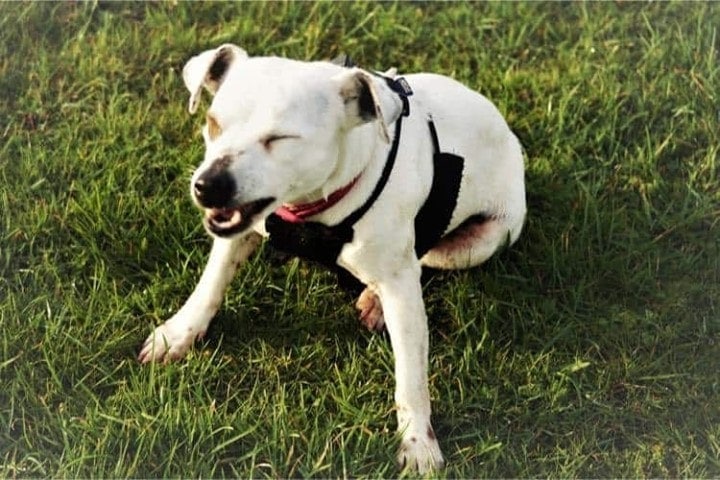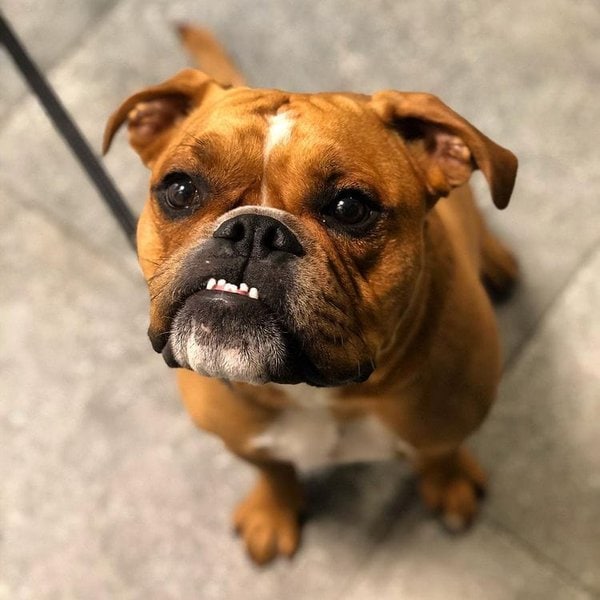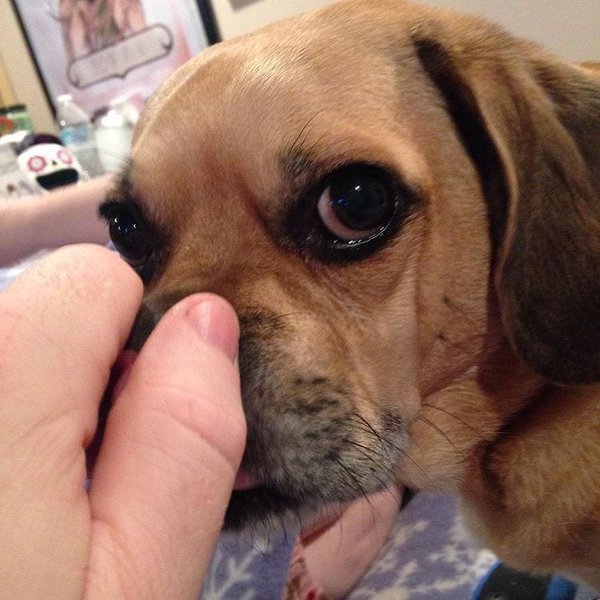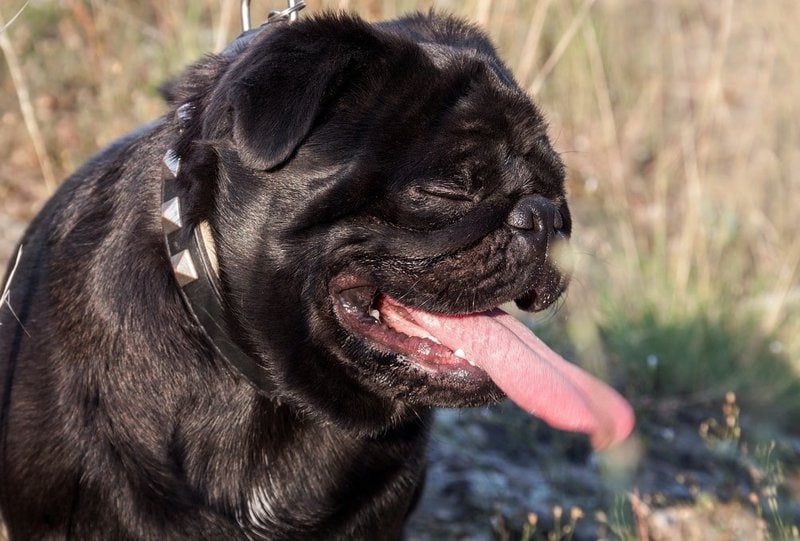Bet you got scared when you heard your beloved dog producing a weird and honking sound as if it is getting choked from something. You run to check if your pooch is in grave danger, but only to find out that it is perfectly fine, standing and staring at you as if nothing has happened.
So, what causes the honking sound coming from your dog? Well, it is called reverse sneezing, and in the medical field, it is referred to as inspiratory paroxysmal respiration. As opposed to a regular sneeze wherein the irritating agent is forcefully expelled out of the nose, the opposite happens in reverse sneezing to dogs.
In this case, the air is forcefully sucked in through the nose when there is an irritating agent in the throat or the soft palate area.
Getting too excited and exercise intolerance are two of the causes of reverse sneezing. Later on, we’d discuss in depth the different causes and what are the treatment options for reverse sneezing.
Should you worry if your pooch is diagnosed with paroxysmal respiration? Let’s find out now.
What Is A Reverse Sneeze?
ContentCon
This is a respiratory condition that happens when there is an irritant in the soft palate, a muscular portion located at the back of the roof of your dog’s mouth. The soft palate assists in the breathing, swallowing, and vocalization of your fur baby.
If regular sneezing removes the irritant from the throat or soft palate by forcing the air out of the nose, it is the other way around for reverse sneezing.
As mentioned earlier, during an episode of reverse sneezing, the air is pulled in the dog’s nasal cavity through a series of rapid and forceful inhalations.
What happens is that an irritant causes muscle spasm in the soft palate that results in the narrowing of the trachea. And, during these moments of spasms that the dog would crane its neck out and try to breathe in a gulp of air causing its chest to expand.
But, because of the narrowed trachea, it prevents the dog from inhaling a full breath of air, hence, the honking or snorting sound is produced.
This episode usually lasts an average of 30 seconds and would just resolve on its own without any ill effects.
What Are The Symptoms Of Reverse Sneezing?
- Repeated and forceful inhalation through the nose
- Snorting, hacking, or honking sound
- Slightly bulging eyes
- Extending the neck straight out or up and down
- Acting perfectly normal before and after the reverse sneezing episode
Reverse sneezing is more typical among brachycephalic dog breeds like the Pug and the Pekingese. This is because of the elongated soft palates and flat faces.
Small dog breeds have smaller throats and windpipes that make them also vulnerable to reverse sneeze.
How Can I Help My Dog During Episodes Of Reverse Sneezing?
In most cases, a reverse sneeze is nothing medically serious. If that’s the case, you can help your dog ease through it by doing any of the following:
- Massaging your dog’s throat to encourage swallowing will usually stop the reverse sneezing.
- You may also gently pinch its nostrils to allow your dog to swallow. Doing this allows the upper airway to open up, thereby, stopping the muscle spasm in the soft palate.
- Placing your finger over the nostrils for about five seconds may help.
- If you’re certain that your dog won’t bite, you can open its mouth and then press its tongue with your fingers. This is done to open the breathing passage and relieve the reverse sneezing.
- You can also take your dog out, away from any household irritants.
- Talking calmly to your fur baby is also useful.
What Are The Causes Of Reverse Sneezing?

The causes of reverse sneezing episodes are known to be a response to something temporary in the dog’s surroundings. Some of these could be due to exposure to a strong scent like perfume or a cleaning product.
Did your dog just have too much of a good time playing? It’s because a vigorous activity can also trigger reverse sneezing, more so for brachycephalic dog breeds.
The same is true when your fur baby gets too excited over something, say a new toy or a treat.
The other triggering factors are:
- Allergies like dusts and pollens
- Pulling on the leash puts strong pressure on the throat
- Eating or drinking rapidly
But, of course, as a fur parent, you should not take reverse sneezing lightly, unless your dog was given a clean bill of health.
Frequent reverse sneezing could be a sign that something medically is wrong with your dog.
When Should I Worry About Reverse Sneezing?
If the frequency of reverse sneezing increases, then it is best if you have your fur baby examined by a vet. If this problem is not properly addressed, respiratory illnesses can also infect your other pets or can worsen and become life-threatening.
Some of the possible medical conditions that trigger reverse sneezing are the following:
Upper Respiratory Infections
Along with reverse sneezing, if you notice that your dog is coughing and is having a hard time breathing, then your dog could be infected with either a viral or bacterial infection in the upper respiratory.
Worse if it’s a case of kennel cough, a very contagious respiratory disease. Apart from honking sounds, sneezing and low-grade fever are some of the other symptoms.

Nasal Mites
As the name suggests, nasal mites live in the nasal passages of dogs. Direct nose to nose is one of the transmissions of nasal mites.
Depending on the severity of the infestation, some of the manifestations are labored breathing, nasal discharge, and reverse sneezing.
Nasal mites can be life-threatening because they can lead to a condition known as alveolar emphysema. A condition that affects the inner walls of the lungs.
Heart Disease
Dogs with heart problems usually suffer from fluid buildup in the lungs. This problem results in coughing and reverse sneezing.
The other health-related explanations for reverse sneezing are collapsed trachea and asthma.
How Is Reverse Sneezing Diagnosed?
If you’re already uncomfortable about the frequency of your dog’s reverse sneezing, you might as well have it examined.
Before taking your fur baby to the vet, recall events such as if your dog was playing rough and what time of the day the reverse sneezing usually happened.
Good if you’ve taken a short video during the episodes, so the vet can easily make a diagnosis.
Here are some of the issues your vet may ask of you:
- How often does reverse sneezing happen?
- When and where do you observe the episodes happen?
- Does your dog show other symptoms like lethargy and yellow or bloody nasal discharge?
- Any changes in the environment like a new diet or did you use a new cleaning product?
- Is there a change in your dog’s routine like a new walking route or any contact with new dogs?
After going through these questions, the vet will perform a physical exam that mainly focuses on the respiratory tract.
Additionally, an X-ray and rhinoscopy will be done to rule out any health issues.

Can Reverse Sneezing Be Treated?
If the vet has identified the underlying health reason for it, yes, reverse sneezing is treatable.
Antihistamines are prescribed if the cause is an allergen. If the reason is the presence of nasal mites, then there is an appropriate treatment for that.
If there’s a foreign body or a mass in the nasal area, a medical procedure will be done to remove it and to repair the damaged tissue.
If you worry that it could be a case of a collapsed trachea, no worries because there’s a cure for it.
Depending on the seriousness of the case, the treatment for collapsed trachea could either be through the administration of meds or through surgery.
Can Reverse Sneezing Be Prevented?
Assuming that your dog’s case of reverse sneezing is not due to a health problem, it can be quite a challenge to prevent reverse sneezing. It’s because the exact non-medical reason is pretty hard to identify.
But, don’t feel bad because there are some things that you can do to minimize reverse sneezing such as:
- If you notice that it happens during your walks, switch from a neck collar to a harness.
- If it happens while eating, you may prevent your fur baby from eating too fast by switching to slow feeder bowls.
- If it’s an allergen, lessen your usage of strong perfumes and cleaning products.





